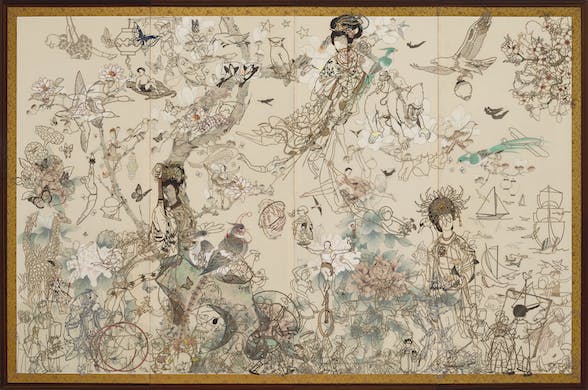Gallery Shows Focus on Medium That Best Fits Our Times: Collage
Credit its ascendance to the advent of mass media but also to a sense that life is less a harmonious totality of events than a collision of often incompatible realities.

‘Idyll-Idol,’ Ryan Lee Gallery;
‘Cut,’ Foley Gallery
It’s become something of a truism that contemporary life has taken on the character of collage, the artistic medium that had its origins in China more than 2,000 years ago but that took on a startling independence in the 20th century.
Credit its ascendance to the advent of mass media — think of all those newspapers and magazines to cut up and reconfigure — but also to a sense that life is less a harmonious totality of events than a collision of often incompatible realities. A better analogy for internet culture would be difficult to find.
Two gallery exhibitions on view in Manhattan provide New Yorkers with the opportunity to consider the state of collage during the age of Photoshop, “deepfake” imagery, and printed journals giving way to online forums.
Artists whose metier these days includes scissors, glue, and print find themselves increasingly particular about materials — out of necessity, sure, but also as an artistic choice.
Josh Dorman has long favored working with maps, periodicals, diagrams, and textbooks that sometimes date back to the 19th century. In “Idyll-Idol,” an exhibition of mixed-media pictures at Ryan Lee Gallery, Mr. Dorman evinces a “new” old material: wallpaper dating from the 1930s through the 1950s.
Augmenting these vintage sources with ink, acrylic, resin, and the occasional length of thread, Mr. Dorman is an intensive fabulist, a conjurer of expansive vistas that coalesce into either cock-eyed pastorals or vertiginous dreamscapes that evince Surrealist intent. Mr. Dorman reaches back further than Freud for inspiration: Bosch and Breughel offer better points of comparison, both in terms of attention to detail and an abiding sense of moral probity.
We have a pretty good idea of the story Bosch was illuminating in “The Garden of Earthly Delights,” but what is Mr. Dorman up to in “Fruiting Season” (2022)? Inventorying its contents is, if not a fool’s pursuit, then a task that risks robbing the image of its hurly-burly allure.
Nature and industry are held in counterpoint, with areas set aside for an obscured panoply of Great Men, a threatening vertiginous whirlpool, and a peppering of exotic beasties. Viewers who like their absurdism parceled out like Easter eggs will find more than enough to puzzle over in Mr. Dorman’s art.
On the Lower East Side, Foley Gallery is hosting “Cut,” a three-person exhibition featuring Bradley Castellano, Keith Maddy, and Billy Renkl. Each artist hearkens, in significant ways, to Modernist precedent and, in the case of Mr. Renkl, the American tradition of silhouettes dating back to the 18th century.
Intimacy is Mr. Renkl’s forte, largely because his formats are preordained: vintage envelopes — hand-addressed, stamped, and, at one point in time, delivered — are the surface upon which he superimposes delicately cut botanical motifs. Wear, tear, and a degree of negligence season Mr. Renkl’s decorative impulses with a patina of nostalgia.
Mr. Castellano’s sizable narrative works expand collage beyond the notion of it being a “kitchen table” medium — that is to say, an art form domestic in both scale and materials. Nature, in Mr. Castellano’s mixed-media works, is pictured as fecund and resplendent, a moody setting suited for rumination and, in the case of “Fire Braider” (2022), rites of a mythological bent. Almost indiscernible slurs of oil and acrylic bestow these dreamscapes with fluidity and finesse.
At the risk of indulging in punnery, Keith Maddy’s collages — some done on paper, the largest on folding panels — are a cut above. Working with coloring books and Asian prints, all of them vintage, Mr. Maddy slices, dices, and recombobulates their imagery with the keenness of a jeweler’s eye.
Technique is paramount, but not the end-all or be-all of Mr. Maddy’s vision. As with any artist worth his salt, materials and process are an inherent component of vision, of creating a compelling reality that our eye can relish and with which the intellect can engage. Mr. Maddy does so through the absurd juxtapositions that are an inherent component of collage, but also by the layering of carefully calibrated oddments. In that regard, he proves an impressive choreographer.
A tour-de-force of lilting rhythms and kaleidoscopic reference points, “Dreaming in the Bough of the Magnolia Tree” (2020) is anchored by Mr. Maddy’s unassailable gift for line. Even without the specific nods to non-Western culture, the piece recalls the calligraphy — both in its propulsion and character — that is a defining characteristic of Asian art. Pop culture, too, filters through the picture, being a marker of memory and, as such, engendering a poignant strain of comedy.
What the future of collage might be is anybody’s guess. Yet for the here-and-now it’s in the purview of artists whose hands, likely sticky with adhesive, are capable of generating a funny and fractured poetry.

